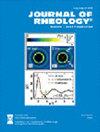跌落液滴尺寸的即时屈服应力测量:“注射器测试”
IF 3.2
2区 工程技术
Q2 MECHANICS
引用次数: 4
摘要
我们分析了通过圆柱模具挤压材料形成的长丝的不同流动状态。我们推断,简单屈服应力流体(即,可忽略触变性效应)的伸长屈服应力可以由丝断裂后液滴的质量和固-液状态转变时掐断临界半径的估计来确定。我们证明,这样一个简单的特性在相对较宽的挤压速度范围内是相关的,即,在这个范围内,这个速度对下落质量有轻微的影响。对于所使用的简单屈服应力流体,Carbopol凝胶,不同浓度的粘土-水膏体和乳液,覆盖了很大范围的屈服应力值(50-1000 Pa),拉伸屈服应力似乎等于简单剪切屈服应力乘以一个等于约的因子[公式:见文本]。因此,这种简单的试验几乎可以在不需要精密仪器(注射器和天平就足够了)的情况下立即获得简单屈服应力流体的剪切屈服应力的良好估计。在这种情况下,不确定性的主要来源(高达约20%)是固液转变时的临界半径值。最后,我们回顾了操作条件(材料特性和挤压特性),我们可以期望这种方法是有效的。本文章由计算机程序翻译,如有差异,请以英文原文为准。
Instant yield stress measurement from falling drop size: The “syringe test”
We analyze different flow regimes of a filament formed by extrusion of a material through a cylindrical die. We deduce that the elongational yield stress of a simple yield stress fluid (i.e., with negligible thixotropy effects) can be determined from the mass of the droplet after filament breakage and an estimation of the critical radius at pinch-off at the solid-liquid regime transition. We demonstrate that such a simple characterization is relevant in a relatively wide range of extrusion velocities, i.e., this velocity slightly affects the drop mass in this range. For the simple yield stress fluids used, Carbopol gel, clay-water paste at different concentrations, and emulsion, covering a large range of yield stress values (50–1000 Pa), the elongational yield stress appears to be equal to the simple shear yield stress times a factor equal to about [Formula: see text]. As a consequence, this simple test may be used to obtain, almost instantaneously and without sophisticated apparatus (a syringe and a balance are sufficient), a good estimate of the shear yield stress of simple yield stress fluids. In that case, the main source of uncertainty (up to about 20%) is the value of the critical radius at the solid-liquid transition. Finally, we review the operating conditions (material properties and extrusion characteristics) for which we can expect this approach to be valid.
求助全文
通过发布文献求助,成功后即可免费获取论文全文。
去求助
来源期刊

Journal of Rheology
物理-力学
CiteScore
6.60
自引率
12.10%
发文量
100
审稿时长
1 months
期刊介绍:
The Journal of Rheology, formerly the Transactions of The Society of Rheology, is published six times per year by The Society of Rheology, a member society of the American Institute of Physics, through AIP Publishing. It provides in-depth interdisciplinary coverage of theoretical and experimental issues drawn from industry and academia. The Journal of Rheology is published for professionals and students in chemistry, physics, engineering, material science, and mathematics.
 求助内容:
求助内容: 应助结果提醒方式:
应助结果提醒方式:


